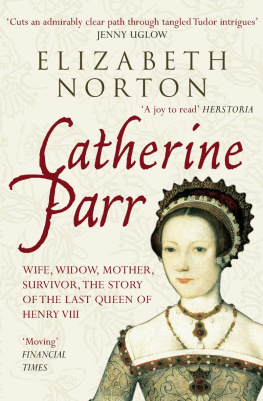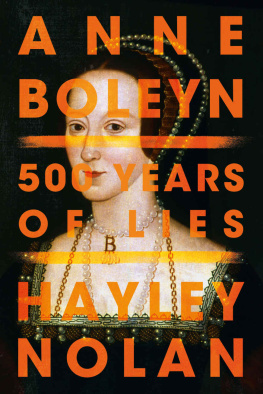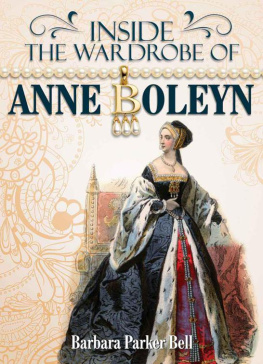All rights reserved. No part of this book may be reprinted or reproduced or utilised in any form or by any electronic, mechanical or other means, now known or hereafter invented, including photocopying and recording, or in any information storage or retrieval system, without the permission in writing from the Publishers.
British Library Cataloguing in Publication Data.
A catalogue record for this book is available from the British Library.
1. The Boleyn women genealogical table.
Part 1
The Earliest Boleyn Women: The Thirteenth to the Fifteenth Centuries
1
NORFOLK ORIGINS
The Boleyn family came to international prominence through the marriage of Anne Boleyn to Henry VIII in 1533. This match, which proved so disastrous for the parties involved, produced Elizabeth I, a queen who was arguably one of the greatest rulers England has ever had. Elizabeth I, as the daughter of a Boleyn, must take her place among the other members of a family which produced a large number of remarkable women. From the queens, Elizabeth I and Anne Boleyn, to the royal mistress, Mary Boleyn, to Anne Boleyn, Lady Shelton, who acted as governess of Princess Mary to Elizabeth Howard, Lady Boleyn, the mother of Queen Anne and her sister, Mary, to Lettice Knollys, a Boleyn granddaughter, who won the heart of Elizabeth Is greatest love, the family produced remarkable and active women, who rivalled and, sometimes, surpassed the men of the family in their political ambition. This is the story of the women of the family, both those who joined the family through marriage and those who were born a Boleyn lady. The family rose from the rank of yeoman, or tenant farmer, to the highest position in the land through the agency of its women, before disappearing once again into obscurity with the death of Elizabeth I, the greatest of the Boleyn women.
The familys origins were deeply unpromising and an observer in the thirteenth, fourteenth and even fifteenth century would never have dreamed that the family would produce two queens of England. The name Boleyn and its various spellings (such as its modern form, Bullen) was not an unusual one. It has been suggested that the name, which was often pronounced and spelled in the same way as the name of the city of Boulogne, denoted a French origin for the family. This is not impossible, but it need not be the case. The earliest ancestors who can be identified were firmly rooted in the county of Norfolk.
The first ancestor who can be identified with any certainty was a John Boleyn, who was living in the Norfolk village of Salle in 1283 when he was noted in the Register of Walsingham Abbey. This Nicholas was a turbulent individual, robbing a man in Lincoln in 1333. That same year Nicholas was ordered by one of the manorial courts in Salle to repair the bank between his land and that of the lord of the manor after he had damaged pastures and trees. At the same time a second John Boleyn makes an appearance in surviving documents relating to Salle, dying soon after his last appearance in 1369. An Emma Boleyn was noted in the Court Rolls for 1377 and it was suggested by W. L. E. Parsons, who carried out a comprehensive review of the early records of the Boleyn family, that she could be identified as John Boleyn IIs widow. If so, she is the first known Boleyn lady. Nothing further is known of her.
John Boleyn II can probably be identified as a son of Nicholas Boleyn. A second man, Thomas Boleyn, was identified as a son of Nicholas Boleyn in a later court case brought by his great-grandson in the fifteenth century. However, given that Thomas Boleyn I only begins to appear in the records in 1370, holding much of the same land as the recently deceased John Boleyn II, he is more likely the son of John than of Nicholas. For Nicholas to have committed theft in 1318, he must have been born by at least 1300. Thomas Boleyn I was still active in 1399 and did not die until 1411, suggesting that he would have been too young to be a son of Nicholas. He is more likely his grandson.
Thomas Boleyn I was married to a lady named Agnes in 1398 when the couple secured an indulgence from the pope. However, she was certainly not Thomass wife in March 1386 and there is no further evidence of a connection between the pair. It therefore seems more probable that Agnes was the only wife of Thomas Boleyn I and the mother of Geoffrey Boleyn I.
Nicholas Boleyn, in spite of his evidently turbulent lifestyle, had been a member of the minor gentry, as is clear from a court case heard in 1463 in which Nicholass great-great-grandson, Thomas Boleyn II, claimed a manor at Calthorpe, called Hookhall as his right and inheritance. Given the fact that the church was built in the early fifteenth century, this window would seem likely to have been a gift made by Thomas Boleyn I, as suggested by Parsons in his history of the parish. This gift would accord both with the piety of Thomas and his wife, Agnes, as evidenced by their request for a papal indulgence and of the rapidly rising status of the Boleyn family in the parish. Nothing more is known of Agnes Boleyn. Thomas Boleyn I died in 1411.
It was Geoffrey Boleyn I, in the early years of the fifteenth century, who extended the familys local prominence. In spite of its small size, Salle supported four manors in the medieval period, all of which were established by the time of the Domesday Book. As such, its church, which has been likened to a small cathedral, is very much at odds with the village and was clearly conceived as a monument to the prosperity of the settlement and its citizens. As Eamon Duffy set out in his study of the parish and church, this huge building was never full and was never intended to be full; its space was intended as the setting for elaborate liturgy and processions, involving the whole parish, but also for the smaller-scale worship in screened-off side chapels, which housed the daily and occasional activities of the guilds and family chantry-chapels. The nave of the church bears the arms of Henry V as Prince of Wales over a doorway, something which suggests that at least part of the structure was built between 1405 and 1413 (before Henry Vs accession to the throne). As such, Thomas Boleyn I and his wife may well have taken an active interest in the building work, as evidenced by the window inscription. Their son, Geoffrey Boleyn I, was one of the leading builders.
In 1408 Geoffrey Boleyn I found himself before the manorial court with six other men, who were all accused of entering the lords manor without permission and occupying part of it with the timber that they had prepared for the church. At the same time they had also broken down one small building on the site, as well as despoiled the lords possessions in the manor house. This was an offence of some seriousness since it represented a direct contravention of the social order in Salle, with tenants actively despoiling the lands of the lord of the manor and, as such, it was deemed too weighty a matter to be dealt with by the manorial court, with the lord and his council to instead consult on a fitting punishment. The reference to the timber for the church makes it clear that Geoffrey was fully involved in the building of Salles grand new church, a building that was largely completed by the newly rich lower-ranking members of the parish, such as the Boleyns, rather than the more established gentry. Later that same year, Geoffrey was once again before the court, this time with the parson of the church at Salle, with both men accused of occupying a ditch or bank belonging to the lord of the manor without permission so that they could store a great ash tree. The assumption must be that this timber was also required for the church and, this time, Geoffrey was dealt with more leniently, being merely ordered to remove the tree within seven days or face its forfeiture.

















